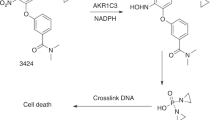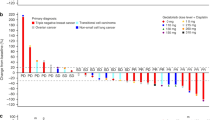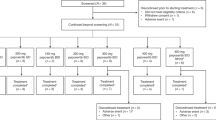Abstract
Decarbazine is an imidazole dimethyltriazene with reproducible activity in patients with metastatic melanoma. CB10-277 is a phenyl dimethyltriazene which, like dacarbazine, requires metabolic activation to its corresponding monomethyl species for antitumour activity. In preclinical models (human melanoma xenografts and transplantable rodent tumours) CB10-277 showed a similar spectrum and level of activity when compared to dacarbazine. Pharmacokinetic studies were performed with CB10-277 in mice treated i.v. at the LD10 (750 mg m-2) and plasma analysed by HPLC. The parent drug area under the plasma concentration vs time curve (AUC) was 142 mM x minutes. Drug metabolism occurred as evidenced by the HPLC identification of the monomethyl species (AUC = 8 mM x minutes) as well as other metabolites. A Phase I trial using a short infusion with doses repeated every 21 days has been performed. Thirty-six patients received 80 courses over a dose range of 80-6,000 mg m-2. The dose limiting toxicity was nausea and vomiting which occurred in 80% of the evaluable courses > or = 900 mg m-2. The only other common side effect was a flushing or warm sensation, which occurred in over 75% of courses at > or = 1,350 mg m-2. There were no hemodynamic consequences. Responses occurred in patients with melanoma (one complete, two partial, one mixed/11), sarcoma (one mixed/6) and carcinoid (one partial/l). Pharmacokinetics were performed in 46 courses. The CB10-277 AUC increased linearly with dose (r = 0.9203, P < 0.001) up to 700 mM x minutes at 6,000 mg m-2). Evidence of CB10-277 metabolism was observed, as in mice, by detection of the monomethyl species and other metabolites. However, the plasma levels of the monomethyl species in patients (1.8 and 3.7 mM x minutes at 6,000 mg m-2) were less than those predicted from studies in mice. Despite this, antitumour activity in dacarbazine sensitive histologies was observed and additional studies with CB10-277 are recommended.
This is a preview of subscription content, access via your institution
Access options
Subscribe to this journal
Receive 24 print issues and online access
$259.00 per year
only $10.79 per issue
Buy this article
- Purchase on Springer Link
- Instant access to full article PDF
Prices may be subject to local taxes which are calculated during checkout
Similar content being viewed by others
Author information
Authors and Affiliations
Rights and permissions
About this article
Cite this article
Foster, B., Newell, D., Carmichael, J. et al. Preclinical, phase I and pharmacokinetic studies with the dimethyl phenyltriazene CB10-277. Br J Cancer 67, 362–368 (1993). https://doi.org/10.1038/bjc.1993.66
Issue Date:
DOI: https://doi.org/10.1038/bjc.1993.66
This article is cited by
-
Evaluation of rodent-only toxicology for early clinical trials with novel cancer therapeutics
British Journal of Cancer (1999)



